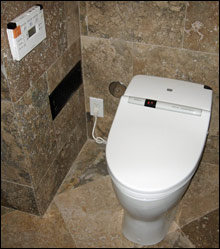
The TOTO Neorest 500 |
Bathroom math used to be simple: Number 1 or Number 2. That was it.Lately, however, with lavatories at the forefront of the eco-craze, things have gotten complicated. The numbers 5.5, 3.5, and 1.28 (as in gallons per flush) have entered the equation. Plumbers are using phrases like "high efficiency" and "pilot-operated fill valve." One toilet — the Neorest, by TOTO — even has a remote control.
All of this toilet talk can be overwhelming — too much to flush, you might say. Thankfully, the folks at Ardente Supply Company, Providence's third-generation potty purveyors, are happy to explain.
"No one thinks to change their toilet," says Michael Ardente, a marketing rep at Ardente. "People say, 'How much could they have changed?' "
Well, after a look at the gadgetry in Ardente's Valley Street showroom — heated seats, de-odorizers, retractable bidet spouts — the answer is clear: a lot.
"Bathrooms are no longer bathrooms," says Evan Ardente, the company's vice president (and Michael's uncle). "They're showplaces. They're spas. They're the selling piece for a house."
Luxury, Ardente maintains, is always a motivating factor ("$100,000 [for a bathroom] is not unheard of.") in bathroom renovation. But a great deal of consumer interest has drawn from environmental concerns as well.
"Green is big," he says. "It isn't an inconvenience like it used to be. It used to be that if you went 'green,' you got half a flush. You had to flush twice."
Toilets, in terms of flush volume, Ardente explains, have made huge advances since the water-chugging, pre-1950 Dark Ages. The standard seven gallons per flush dropped to 5.5 in the 1960s, and then to 3.5 in the 1980s.
Nowadays, Ardente says, industry leaders like TOTO, a Japanese company, produce toilets at 1.28 gallons per flush — even less than the 1.6 required by our 1992 National Energy Policy Act. ("If every US home replaced one toilet with a 1.28 gpf high-efficiency model," TOTO's Web site reads, "it would save more than 900 billion gallons of water per year — equivalent to the amount of water that flows over Niagara Falls in a two-week period.")
TOTO has also ramped up US production of dual-flush toilets — with individual buttons for Number 1 (0.9 gpf) and Number 2 (1.28 gpf) — those giggle-inducing, eco-friendly johns that Europeans have been using for years.
While all of this toilet technology may sound pricey, updating to greener toilets, Ardente says, as such local clients as Lifespan and Roger Williams University have been doing, is good business.
"It's environmental, it's financial," he says. Because of reduced water bills, "the smart owners of apartment buildings have been throwing those three-gallon toilets in the Dumpster. [The new toilet] pays for itself."
Ardente finished by flushing fears that, like cars or computers, high-efficiency toilets will be outdated as soon as they roll off the showroom floor. Don't worry, he says. Toilets, to do their job, will never go below a certain flush volume. Or as he put it: "Not unless they start burning it!"